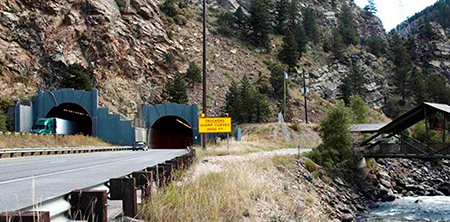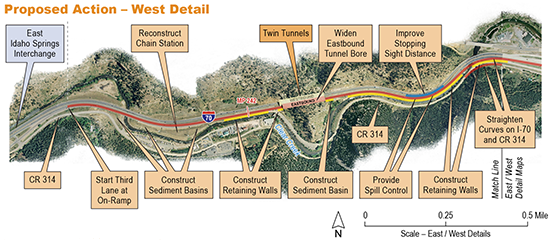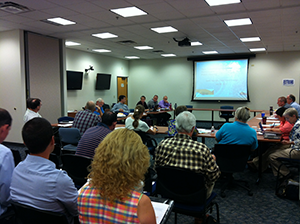CDOT Uses Stakeholder Involvement to Streamline
Environmental Review Process for Twin Tunnels Project
Across the country, State Departments of Transportation are implementing streamlined environmental review processes to accelerate the delivery of transportation projects while protecting the environment. For over a decade, the Federal Highway Administration (FHWA) has worked on a variety of initiatives focused on environmental streamlining, including most recently the Every Day Counts (EDC) initiative. FHWA first introduced the EDC initiative in 2010 to reduce project delivery times while improving safety and avoiding or mitigating impacts to the environment. EDC does this by identifying technologies and processes that meet project goals in less time, and by avoiding the duplication of efforts in the planning and environmental review processes. For example, Planning and Environment Linkages, a component of EDC, takes environmental, community, and economic information collected early in the planning stage and carries it through project development, design, and construction.
As part of the EDC initiative, FHWA developed the Shortening Project Delivery Toolkit that States, Metropolitan Planning Organizations, and their partners can use to help expedite project delivery. Five of the tools in the toolkit are relevant to environmental streamlining:
- Planning and Environment Linkages,
- Legal Sufficiency Enhancements,
- Use of In-Lieu Fee and Mitigation Banking,
- Clarifying the Scope of Preliminary Design; and
- Enhanced Technical Assistance on Ongoing Environmental Impact Statements (EIS).
Further information on these tools is available at FHWA’s EDC website.

The Twin Tunnels are located in an environmentally sensitive area due to wildlife and a nearby stream. (Courtesy of CDOT)
Colorado Applies EDC Principles
The Colorado Department of Transportation (CDOT) applied the principles of EDC in developing the Environmental Assessment (EA) for its I-70 Twin Tunnels project to streamline development efforts, reduce duplication, and inform decisionmaking. The Twin Tunnels EA, which was completed in July 2012, is CDOT’s first Tier 2 National Environmental Policy Act (NEPA) process that follows the interagency involvement commitments of the I-70 Mountain Corridor Programmatic EIS (PEIS). The I-70 Mountain Corridor PEIS serves as a guide for CDOT’s collaborative efforts, as well as for data collection and analysis activities for all transportation improvements within the I-70 Mountain Corridor, including the Twin Tunnels project. This corridor-specific guidance, which has been developed from stakeholder input, incorporates Context Sensitive Solutions (CSS) into the NEPA process. CSS stresses the consideration of social, economic, and environmental context in decisionmaking.
To keep consistent with the PEIS, CDOT implemented a collaborative approach to the Twin Tunnels project. CDOT involved stakeholders in creating the foundation for transportation improvements in the area, defining those improvements through a visioning workshop, and developing design concepts for the project. These activities ensured that stakeholder input informed all project-level decisions made throughout the process. This streamlined the process by minimizing conflict over design changes that often occur late in the process for projects as complex as the Twin Tunnels. Construction on the Twin Tunnels project began in late fall of 2012 and is scheduled to continue through summer 2014.
Twin Tunnels Project Area Problems and Proposed Solutions
The Twin Tunnels are part of Colorado’s I-70 Mountain Corridor, which is the only east-west Interstate route through the State. The tunnels bore through a large rock outcropping that is part of the Rocky Mountain Range, and they provide vital access to many popular tourism and recreation areas. CDOT has identified the Twin Tunnels area as a severe bottleneck in the 144-mile stretch of I-70 that connects the Denver metropolitan area to Glenwood Springs, especially in the eastbound direction. On Sunday afternoons, travelers returning to the Denver metropolitan area from the mountains experience extreme and often unpredictable delays. The corridor’s unique geometry, including narrow tunnels and sharp horizontal curves, creates sight-distance issues. These issues are prime contributors to crashes, especially in icy and snowy conditions. The severe congestion, narrow shoulders, and lack of alternate east-west routes also create problems for emergency vehicle response.
The Twin Tunnels project will add a third lane of highway capacity for four miles in the eastbound direction from the east end of Idaho Springs to Floyd Hill. The project requires state-of-the-art blasting techniques to widen the eastbound tunnel. CDOT is also making some geometric improvements to straighten the most dangerous horizontal curve in the project area, which will improve safety. In addition to the congestion and safety issues in the corridor, CDOT is addressing historic preservation and ecological sensitivity as part of the Twin Tunnels project. The tunnels themselves are of local historical significance because they represent the first successful tunneling operation on I-70. They are included on FHWA’s Final List of Nationally and Exceptionally Significant Features of the Federal Interstate Highway System.
Accelerating Project Delivery through Stakeholder Involvement

The Proposed Action employs many different types of transportation improvements. (Courtesy of CDOT)
CDOT took a multi-pronged approach to accelerating the delivery of the project. One important element was early and continuous engagement with partner agencies and the public. CDOT held scoping sessions early in the process with Federal, State, and local stakeholders to identify concerns and opportunities for addressing those concerns. This information helped CDOT define the Proposed Action, understand its impacts, and develop measures that will result in a project that is respectful of its surroundings and values of the stakeholders. CDOT also held a large public meeting with business leaders and residents in the communities to further inform the scoping process. Additionally, CDOT established several Issue Task Forces to provide guidance on topics like wildlife mobility, stream and wetland enhancement, and historic resources.
To supplement early stakeholder engagement, CDOT formed several multiagency teams to promote coordination among the various stakeholders. The Project Leadership Team, which consisted of CDOT, FHWA, city and county elected officials, and the consultant management team, was responsible for moving the decisionmaking process forward. It used public input to identify a set of core values: sustainability, collaborative decisionmaking, safety, healthy environment, historic context, communities, mobility and accessibility, and aesthetics. The Project Leadership Team also ensured that the CSS guidance and core values were integrated into decisionmaking throughout the project.
CDOT also established a Technical Team, which included representatives from FHWA, CDOT, the consultant team, local public health and environmental departments, and experts on various topics such as natural and built environment, aesthetics, community and business interests, recreation, traffic, emergency services, construction, and historic resources. The Technical Team’s objective was to recommend a Proposed Action to implement transportation improvements in the Twin Tunnels area. Additionally, the Technical Team provided input on impact evaluation and mitigation recommendations. The Technical Team held monthly meetings to discuss the key issues and opportunities identified through the public scoping meeting and meetings with the various Issue Task Forces.

Public outreach was a critical component of CDOT’s strategy. (Courtesy of CDOT)
Benefits of Stakeholder Involvement
CDOT’s collaborative process to develop the EA for the Twin Tunnels project demonstrates how extensive stakeholder involvement can be used to streamline a project. A holistic visioning process, such as this one, ensures that all involved parties have their voices heard. The collaborative process also gave the various stakeholders ownership and kept them committed to the project by participating in frequent meetings throughout the year. This provided quick feedback and the necessary support to move the project forward. By having a process that included regular opportunities for stakeholder input on the project’s goals, core values, criteria, and desired outcomes, CDOT was able to accelerate the project schedule and avoid backtracking, which is common in project development processes that do not use the principles of EDC. CDOT’s collaborative approach demonstrates that building trust with stakeholders at all levels is an integral part of expedited project delivery. FHWA formally recognized CDOT’s achievements with a 2013 Environmental Excellence Award for Environmental Streamlining.
Contact Information
David Singer
Region 1
Colorado Department of Transportation
(720) 497-6960
david.singer@state.co.us
Melinda Urban, P.E.
Colorado Division Office
Federal Highway Administration
(720) 963-3015
melinda.urban@dot.gov
Look What’s New!
- FHWA recently released a video that highlights the Kentucky Transportation Cabinet’s use of programmatic agreements to expedite project delivery while preserving the environment. FHWA produced the video as part of the EDC initiative. To view the video, click here.
Successes in Stewardship is a Federal Highway Administration newsletter highlighting current environmental streamlining and stewardship practices from around the country. Click here to subscribe to the newsletter, or call 617-494-2092 for more information.

